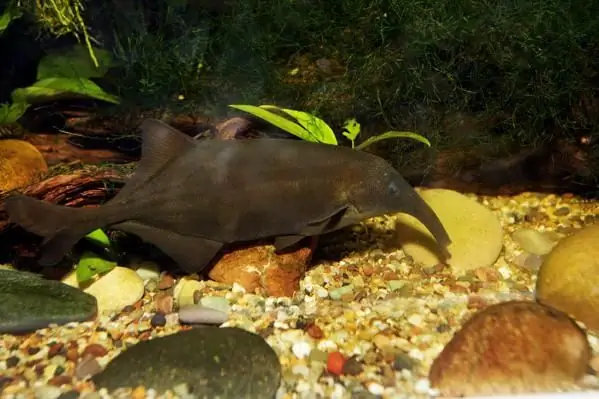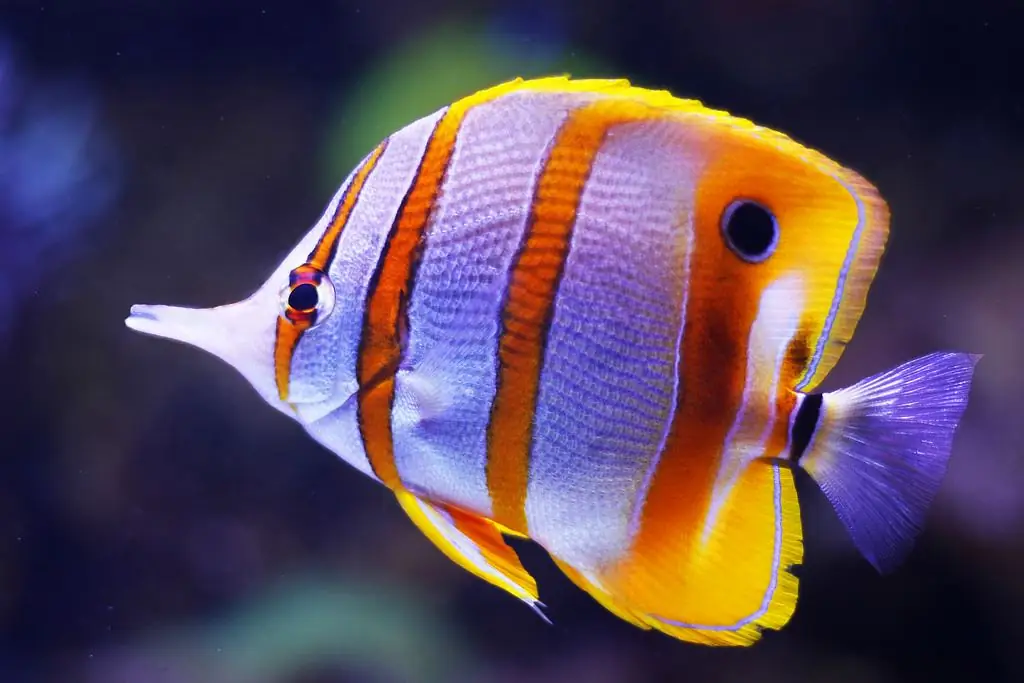2026 Author: Priscilla Miln | [email protected]. Last modified: 2025-01-22 17:55:21
Elephant fish lives in the Congo River and the rivers of Cameroon. This species first came to Europe in 1950, in the USSR - in 1962. The length of an adult individual reaches 23 centimeters. The body is rather elongated, but laterally flattened. The pectoral fins are high, the dorsal fin is shifted far back. The elephant fish does not have ventral fins, as for the color, its color is dark brown. There is a rather large black spot between the dorsal and anal fins.
Elephantfish
The fish got its name because of the proboscis located on the lower part of the jaw, the size of which is equal to two centimeters. The proboscis looks like a rounded long stem.

The so-called trunk is necessary for the fish in order to find food for itself. The life expectancy of this species in natural conditions is eight years on average. Water "elephants" are difficult to distinguish by gender, the only difference is that females are larger than males. Fish have an amazing feature, namely, thanks to electric fields, they find their way in the dark. They are also able to distinguishdead and living beings. The river elephant prefers to swim closer to the bottom. The fish looks like a mine detector.
Aquarium and elephant fish
The maintenance and reproduction of these fish, like many large varieties, should take place in an aquarium with a volume of more than 120 liters. The aquarium must be tightly closed with glass, otherwise the fish will jump out of it.

"Elephants" are not too demanding on the chemical composition of water. In order for the fish to feel comfortable, shelters in the form of stone caves, dense thickets, and flower pots should be arranged in the aquarium. As for the soil, it should be loose and soft. This is necessary so that it can settle after agitation in a few minutes. Washed peat chips can be used as soil. Most of the life of the elephant fish is in motion, only for a short time it can be in a calm state. This species is constantly chasing similar fish, and sometimes pursues large fish without a special purpose. The underwater elephant does not pay any attention to small specimens. They can be compared to playful baby elephants who just want to frolic.

The smartest fish
Many connoisseurs of aquatic life believe that the elephant fish is the smartest fish. In order to get food for herself, she plunges her head into the mud and looks for food with the help of her trunk. When a bloodworm is found in a thick layer of silt, the movable trunk throws it up. Thereafterthe bloodworm is drawn into the mouth opening, which is located under the trunk. Under natural conditions, elephant fish sink into the mud until only the dorsal fin is visible. On their back they have an organ called an "electrolocator". Thanks to him, an approaching enemy will be seen at a distance of several meters. Many scuba divers like to take photos of bizarre fish, including the elephant fish. Her photo adorns many thematic publications.
Recommended:
I want a family and children. Single life - pros and cons. Preparing for family life

"I want a family" - this desire sooner or later arises in the minds of almost all people. But is married life really that good, or is it better to stay single? If you still create a family, then how to prepare for this serious step? This post will answer these questions
Parrot fish: description, features of keeping in an aquarium

Those who already have a good collection of fish sometimes want something exotic, but you can't always get it in pet stores. It is worth noting that many fish are quite expensive in terms of cost and troublesome to maintain. But there is one "live option" that wins hearts, differing not only in an affordable price, but also in incredible beauty. This choice becomes a parrot fish that brings a lot of pleasure
Tropical fish for an aquarium: species, features of keeping, feeding, reproduction

Tropical fish are quite popular in home aquariums due to their exoticism and bright colors. There are species that even a beginner can contain without much difficulty. Tropical inhabitants are quite thermophilic, they can be kept in fresh and s alt water. Consider the main species that are often found in home aquariums, the conditions of keeping, feeding and breeding
Dwarf elephant: photo, dimensions. Dwarf elephant at home

Did you know that there is a pygmy elephant? Photos of pygmy elephants just flooded the Internet. Fans of these cute animals are already fantasizing that such a baby can definitely be kept as a pet in an apartment. Let's see if a pygmy elephant can live at home, what he eats, how he behaves in the wild
Kerry Blue Terrier: the nature and complexity of keeping, illness and care

One of the oldest dog breeds that originated in Ireland is the Kerry Blue Terrier. For the Irish people, it is considered the national symbol of their country. This pet is very peculiar both in appearance and in character. What features distinguish it from other dog breeds? Complete information about this unusual pet will help answer this question

